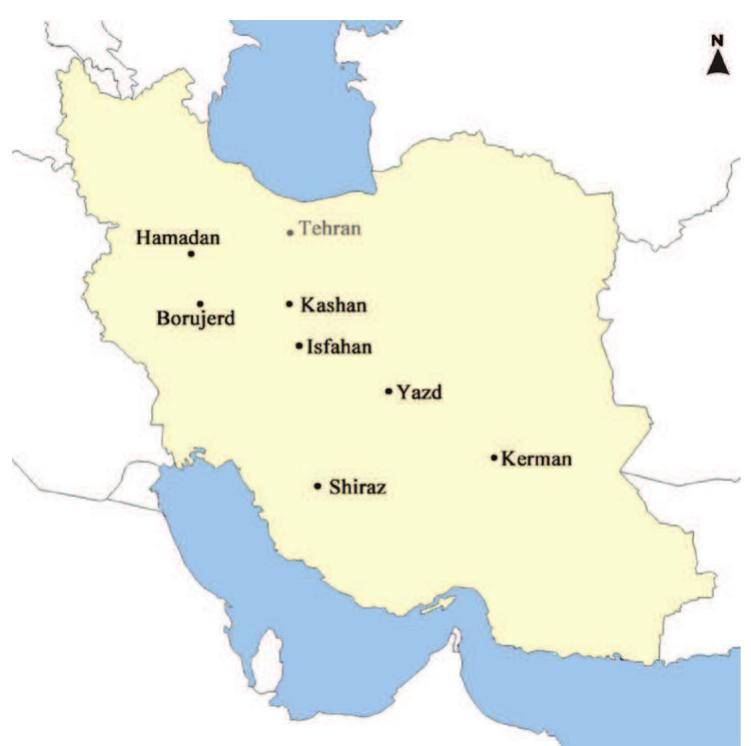Johnson, Scott Fitzgerald. 2018. “The Languages of Christianity on the Silk Roads and the Transmission of Mediterranean Culture into Central Asia.” In Empires and Exchanges in Eurasian Late Antiquity: Rome, China, Iran, and the Steppe,... more
From the fourteenth to the eighteenth centuries, Indian intellectuals produced numerous Sanskrit-Persian bilingual lexicons and Sanskrit grammatical accounts of Persian. However, these language analyses have been largely unexplored in... more
This article constitutes a preliminary attempt to explore the geographical dimension of premodern Persian lyric poetry from the perspective of the relationship between the historical adherence of a text to external reality and the... more
This paper discusses a phenomenon that has recently been observed in areas with a large migrant population in European cities: the rise of new linguistic practices among adolescents in multiethnic contexts. The main grammatical... more
Persian complex predicates pose an interesting challenge for theoretical linguistics since they have both word-like and phrase-like properties. For example, they can feed derivational processes, but they are also... more
There have been a number of important efforts to map out the languages of Iran, but until now no language atlas, or even a comprehensive and detailed country-level language map, has been produced. One of the recent initiatives which aims... more
Language documentation has been carried out in Iran since the late 1800s but in a sporadic way, and even now, the scholarly picture of the country's linguistic landscape is fragmentary. The present article responds to this state of... more
This paper is the first substantial study of the Jilwa-yi ẕāt, an unabridged Persian verse translation of the tenth skandha of the Bhāgavata Purāṇa, completed in Delhi in 1732–33 by Amānat Rāy, a Vaiṣṇava pupil of the influential... more
Brahman Sanskrit intellectuals enjoyed a century of relations with the Mughal elite. Nonetheless, such cross-cultural connections feature only sporadically in Persian chronicles, and Brahmans rarely elaborated on their imperial links in... more
In the late sixteenth and early seventeenth centuries, Jain leaders faced a series of religious questions at the royal Mughal court. At the request of their imperial Muslim hosts, Jain representatives discussed aspects of both Islam and... more
The present study investigates immigrant parents’ family language policies in regards to their children’s heritage language development and maintenance by utilizing Spolsky’s theoretical model on which research on family language policy... more
Since the late 19th century, despite multi-cultural and multilingual composition of Iranian population, Persian nationalism has functioned as the ideology of the state. Persian intelligentsia have formulated a set of historical and... more
The ideology and worldviews of a community may be shifted and modified through social changes brought about by political upheavals. In a country like Iran, the Islamic revolution (1979/80) has played a major role in re-shaping the... more
Persian language manuals uniformly adopt national categories such as Persian/Farsi (Iran), Dari (Afghanistan) and Tajik (Tajikistan). These categories at once impose an imagined contrast between the languages at the high register that is... more
The Iranian languages spoken by the Jews are often lumped under the term “Judeo-Persian.” Yet properly construed, the latter term refers to forms of Persian written with the Hebrew script. The corpus of Judeo-Persian texts is significant... more
Delaying the appearance of a verb in a noun-verb dependency tends to increase processing difficulty at the verb; one explanation for this locality effect is decay and/or interference of the noun in working memory. Surprisal, an... more
A Sequence Recall Task with disyllabic stimuli contrasting either for the location of prosodic prominence or for the medial consonant was administered to 150 subjects equally divided over five language groups. Scores showed a significant... more
This paper deals with the presentation and evocation of emotion in performative face-to-face linguistic communication in Iran. Performance in linguistic communication is shown to involve the speaker's need to convey an impression of his... more
Two experiments were carried out to examine whether the Persian word accent is deleted in two putative deaccenting contexts, post-focal regions and presupposed embedded clauses, to the extent that accentual minimal pairs become... more
A sociolinguistic analysis of emotion in Iranian culture and language use is developed. The work of Friedrich, Bateson, and others is drawn on to indicate how emotion is represented though metacommunicative, paralinguistic, and stylistic... more
This paper describes an implemented fragment of Persian.
The aim of this study was to develop and validate the Childhood Nonverbal Communication Scale (CNCS) to assess nonverbal communication skills in children from birth to 18 months old. An extensive review of existing research provided... more
This paper focuses on Vahshi Bāfqi (d. 991/1583), especially on the sources for the study of his biography and works. The various editions of his collected poems are assessed. Next, all of the known early sources on Vahshi’s biography are... more
Emotion and instantaneous choice in interactional linguistic pragmatics: Cross-cultural perspectives
Highlights • I present an explanation of instantaneous pragmatic linguistic choice behavior. • I posit “thin slicing” and “emotional response” behavior as mechanisms. • My conclusion supplements other explanations based on... more
This study concerns the native language of Shirazi Jews, most of whom are living in diasporic communities outside Iran. The language, Judeo-Shirazi, belongs to the Southwest Iranian group, as do most other native languages spoken in... more
This chapter introduces Native Language Identification (NLID) and considers the casework applications with regard to authorship analysis of online material. It presents findings from research identifying which linguistic features were the... more
This paper describes the CoreGram project, a multilingual grammar engineering project that develops HPSG grammars for several typologically diverse languages that share a common core. The paper provides a general motivation for doing... more
This paper examines the acquisition particularities of advanced-level students. It also investigates the use of content-based—in this case media material—in teaching advanced-level students, as well as the impact of teaching such material... more
Unlike previous studies, this book steps outside disciplinary and regional boundaries and gives comparative insights into the factors behind uniformity and variation in the Arabic-influenced writing traditions where cultures, languages... more
Khargi is spoken on the island of Kharg in the Persian Gulf. A member of the Southwest branch of the Iranian languages, Khargi is related to the languages spoken in the province of Fārs and along the coastal line down to the Strait of... more
Prosody plays an influential role in the recognition of Persian wh-in-situ questions (Shiamizadeh et al., in press). Perception of speech intonation is supported by several prosodic correlates (Lehiste, 1970). For instance, perception... more
Öz Tarihî süreç içerisinde yoğun bir etkileşimde bulunan Türkçe ve Farsça birbirlerini etkilemiş, birbirleriyle kelime aşıverişinde bulunmuşlardır. Her iki dilin söz varlığında çok sayıda ortak kelimenin birikmesiyle, sonuçlanan bu... more
The present study aimed to investigate the role of gender in Persian verbal humor. To do so, based on an Iranian mobile app, 354 trending jokes (‘liked’ by at least 50,000 users) were selected and scrutinized to discern how male and... more
Persian language has no functional equivalents of the English article system and many Persian ESL learners have difficulty in using English articles, particularly the definite article “the”. This study examined whether the accuracy of... more
Unlike other writing systems that are readily classifiable as alphabetic or syllabic in their structure, the Indic Devanagari script (of which Hindi is an example) has properties of both syllabic and alphabetic writing systems. Whereas... more
Located in the Caspian forest south of the capital city of Sāri in Mazandaran, the rural district of Kalijān Rostāq is home to a number of close-knit villages which share a local Mazandarani dialect. The vernacular offers some authentic... more
Syntactically annotated data like a treebank are used for training the statistical parsers. One of the main aspects in developing statistical parsers is their sensitivity to the training data. Since data sparsity is the biggest challenge... more
Using electropalatographic (EPG) data, we study the coarticulatory effect of intervocalic contexts on the Persian coronal stops [t] and [d]. The EPG patterns demonstrate that [d] is produced in a more anterior place than [t], proving the... more
Modern Persian, also known as Farsi, has recently developed a periphrastic verbal construction to express the progressive and prospective aspects which uses the auxiliary dāštan(inf.)/dār- (pres. stem) ‘to have’. This construction was... more
It has been repeatedly observed that focus substantially changes the sentence prosody in many languages not only by increasing F 0 , duration, and intensity on the focused components but also by compressing the pitch range and intensity... more
Purpose: In this study, we aimed to translate and test the validity and reliablity of the Persian version ofthe Manchester-Oxford Foot Questionnaire in foot and ankle patients.Methods: We translated the Manchester-Oxford Foot... more
This paper explores the discourse functions of Arabic-Persian codeswitching and the phonological/lexical outcomes of language contact among members of the Āl ʿAlī tribe in the United Arab Emirates and Hurmuzgān Province in Iran. The... more
Food plays a central role in hospitality in virtually every culture on earth. Eating together - 'commensality'' is perhaps one of the most basic human social acts, and is imbued with a special ritual quality. In this paper I show that... more
This paper gives a novel approach of automatic speaker recognition technology, with an emphasis on text-dependent speaker recognition. Speaker recognition has been studied actively for several decades. In fact, Speaker recognition system... more
In Islamic societies, there exists the belief that a compliment can attract the 'evil eye' unless it´s accompanied by expressions that invoke God's protection. The purpose of this research is to analyze the use of these expressions and to... more





























































































